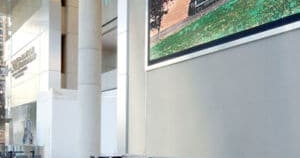We’ve written previously in this space about how casinos and gaming houses can borrow some ideas from sports stadiums. Venues in each industry are dependent on bright lights to guide and engage with their audiences, and use cases for digital display technology are actually quite similar despite the obvious differences in environment. There are countless examples of overlap to be found when it comes to display applications across separate industries, but what about the display industry itself? What other industries can it learn from? Well, for one, the footwear industry. Allow us to explain.
Much like in the display industry, shoe shoppers get what they pay for. While an expensive pair of boots remains sturdy for many years, a cheaper pair of boots needs to be replaced again and again over that same time frame, ultimately requiring a greater total expense from the customer. This concept applies to digital signage hardware and software as well. Buy a durable display solution that can adapt and upgrade as you do, reap the benefits of years of reliable performance. Opt for a cheaper display, be ready to pay that price again and again.
In the display industry, there are two primary technologies: direct view LED and LCD. In the arena of LED vs LCD, nearly everyone with any experience working with these two display types will attest that LCD displays are usually cheaper. They’ll also tell you that there’s a reason for that. Or more accurately, several reasons for that. LCD displays are cheaper because they aren’t as bright as LED displays, they usually aren’t as easily maintained and upgraded as LED displays, and they provide few advantages beyond their receding supremacy in resolution. LCD displays can’t be built in curved shapes, and they contain unsightly bezels when stacked to create a video wall. What’s perhaps most relevant to this footwear comparison however is the lifespan of an LCD display, relative to an LED. In our experience -and in the estimation of countless industry professionals we surveyed- an LED display solution will last about 50% longer than an LCD display under equivalent conditions of operation.
Direct View LED vs LCD: Life Expectancy
This life expectancy is proven out in the warranties each manufacturer provides. For example, the industry-leading warranty that Nanolumens provides covers our LED displays for six full years, but most experts we surveyed expected any given LCD display to last roughly just four. This discrepancy is a product of both the materials used in manufacture and the long term availability of replacement and enhancement parts. LED lamps like the ones we use typically tested to last 100,000 hours until they achieve half-brightness but lower-end diodes like the disparate selection used to cut costs in LCD displays don’t always meet that threshold. LCD manufacturers also regularly sunset their older display models, so what might be a simple part swap for an LED provider is instead a full scale replacement for an LCD supplier.
This longevity of LED more than makes up for the higher initial costs, which we’ll readily admit exist. In our experience and that of the aforementioned respondents we surveyed, customers should expect an LED to cost about 30-35% more than an LCD, though this evens out over time as LCD hidden costs spring up. That means customers opting for LED over LCD will get roughly 50% more usage from their purchase while only paying around 33% more. We’ve written at length about how LED displays offer a better total cost of ownership than LCD displays, and this value dynamic perfectly reflects the maxim of getting what you pay for.
So when it comes to LED vs LCD, the question isn’t really how much you want to spend. It’s whether or not you want to keep spending again and again to repair and replace technology you’ve already bought. If that sounds good to you, that’s your prerogative. If that sounds like a nightmare, and you’d much rather have a display solution you know is going to return greater proportionate value, give us a call! Buy the good boots. Buy LED. You’ll be glad you did.

